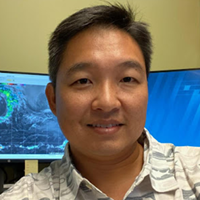Eric Lau
Location: Honolulu, HI
Office:Pacific Region Headquarters
Job Title: Chief, Environmental Scientific & Services Division (ESSD)
Educational Background:
- B.S. Meteorology, University of Hawai‘i at MÄnoa
M.S. Meteorology, University of Hawai‘i at MÄnoa
Describe the career path that led you to your current job with the National Weather Service.
- During graduate school at University of Hawaii, I was in the Student Career experience Program (SCEP) at WFO Honolulu. After graduation, I worked at WFO Eureka, CA as a meteorologist intern and then a general forecaster. After 3 years in Eureka, I was fortunate to move home to Hawaii as a general forecaster at WFO Honolulu. Then I transferred to the Pacific Region Headquarters as the Scientific Services Meteorologist/AWIPS Program Manager and did that for 12 years. In 2020, I was promoted to the Chief of the Environmental Scientific and Services Division (ESSD).
What do you do for the NWS?
-
As Chief of ESSD, our team covers a wide array of programs with activities across all portfolios. We oversee the operations across the Pacific at our Weather Forecast Offices (WFO) in Honolulu and Guam, Weather Service Office (WSO) in American Samoa and 5 WSOs across Micronesia. Although we have only a small amount of offices, each one is quite different and unique operationally.
Aside from the 11 Analyze, Forecast, and Support (AFS) Service Program Team and the Science and Technology Integration (STI) Science working groups, we also manage the AWIPS program and ensure operations across the region. Our ESSD has oversight of infusing new science and technology such as new satellite imagery and model data. We also oversee the regional training program, the surface observations program and the upper air programs across the region. ESSD also staffs the Regional Operations Center (ROC) alongside our dedicated Emergency Response Specialists.
What was the most interesting, exciting, or impactful weather/water event you experienced while working for the NWS and why does it stand out?
- Most recently, it was category 4 Hurricane Lane approaching the Hawaiian Islands from the south in 2020. A hurricane of this magnitude would devastate the islands. There was a lot of uncertainty with the track and the anticipation of Lane making a sharp left turn away from the islands as it was meandering west of the Big Island. Being able to provide the support and Impact-based Decision Support Services (IDSS) for our Federal, State and local partners was a rewarding experience.
What made you decide to pursue a career with the NWS?
- As a kid growing up on the island of O‘ahu in Hawai‘i, I was always fascinated by the weather and curious about the various climates across the island. My fascination for weather solidified when I was glued to the tv as Hurricane Iniki made landfall on Kaua‘i in 1992.
What do you like most about working for the NWS?
- The people of NWS and the collective dedication each one of us has to the mission for protecting life and property. We’re all in it together.
What advice do you have for someone interested in a career with the NWS?
- If you love the mission, the NWS is for you. It’s not just for people interested in the atmospheres and the oceans. No matter what career path you are going down, there are other opportunities which support the mission, such as finance/budget, IT, electronics, administrative, and program management.
What training or coursework would you recommend to someone interested in following your career path?
- Along with the requirements for meteorology, look into learning some emerging technologies such as artificial intelligence and machine learning. Also with IDSS, courses in social, behavioral and economic sciences would be beneficial.
